2020 is over and what many expected finally happened: Voice search DIDN’T become the mainstream way to search. In any case, search is becoming more visual, which shouldn’t surprised us since 2 years ago Google directly mentioned that 1 of the 3 fundamental shifts in how they think about search in their next chapter was going to be “the shift from text to a more visual way of finding information” (along the shift from answers to journeys and a queryless -predictive- search experience).
With search, SEO is also in a continuous evolution: although we can argue its pillars haven’t changed (crawlability, indexability, relevance, popularity), there are certainly additional layers of complexities with signals, opportunities and challenges for SEO success today that didn’t existed 10, 5 or even, were not as critical in some cases just a couple of years ago.
I can see how the evolution of SEO is driven by two group of “forces”:
- User search behavior & Search engine functionality & experience
The shift of how people search and search engine’s presentation and algorithmic improvements to better tackle users search behavior to provide the best experience while fueling their own growth and user retention. - The evolution of Websites Tech Stack & Level of SEO Competition in each market
The added complexity of Websites used tech stack, specifically Web frameworks (hello JS), as well as growing competitiveness -and barriers to entry- across the most profitable online sectors -driven by the higher SEO maturity of Web industries leaders and high growth goals of startups-.
But, how this evolution really impacts our day to day as SEO specialists for 2021?
Let’s go through some core areas that are more important than ever and aspects that are highly negative and should be stopped or avoided as much as possible for your SEO success in 2021:
- To Maximize:
- Aligning SEO efforts with your Website’s Product Triangle for an strategic approach within your company
- Understand and connect with your audience search Intent to become the best comprehensive answer for the queries that actually matter
- Expanding your Presence and Visibility Share leveraging Google’s Search Features and Discover
- Growing and Leveraging Your Brand Authority
- To Stop:
To Maximize:
1. Aligning SEO efforts with your Website’s Product Triangle for an strategic approach within your company
Why is this so important in 2021?
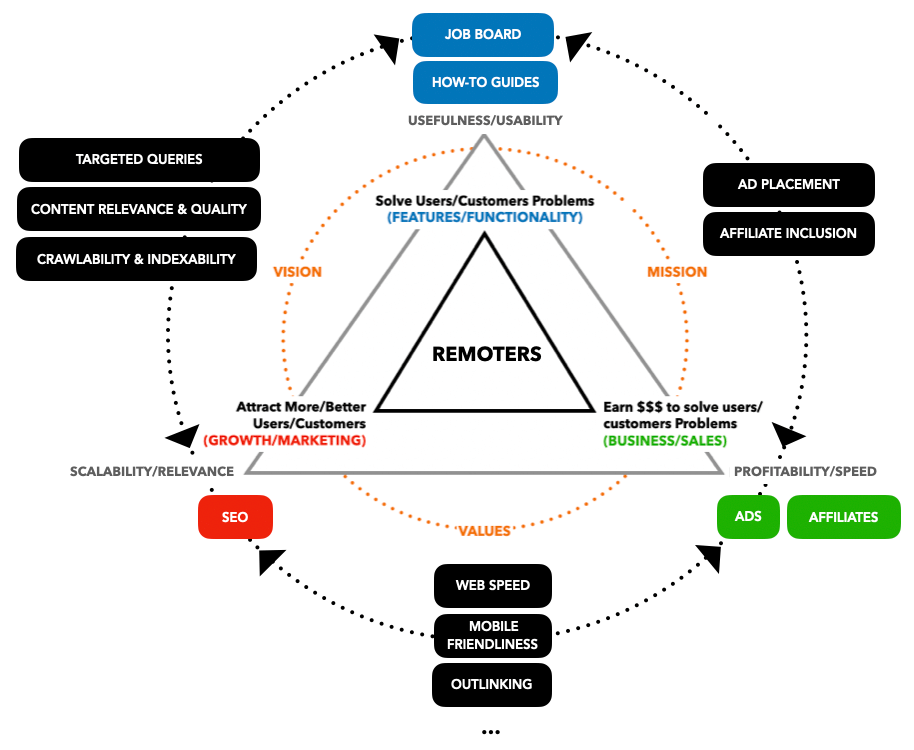 Still today there are SEO processes driven by a checklist of unconnected SEO tactics that don’t take the business context and goals into consideration.
Still today there are SEO processes driven by a checklist of unconnected SEO tactics that don’t take the business context and goals into consideration.
These are processes that don’t align SEO within other marketing/growth activities nor integrate it within the company’s business/sales and features/functionalities efforts. Ultimately, these SEO processes have higher chances to not achieve meaningful results, especially within competitive sectors and complex organizations.
Establishing a well aligned SEO strategy, integrating SEO within the Website product triangle is therefore more fundamental than ever and should be the base for a successful SEO process.
What will you achieve with it?
- Avoid implementing “disconnected” SEO Tactics that might not be relevant within your context and won’t help you to achieve your goals
- Be more effective when setting an SEO strategy aligned with the company’s business, functionalities and growth goals
- Align efforts and gain support across the different areas/departments within the company towards SEO efforts
- Be more competitive in mature sectors
Key Questions to ask:
- What’s the ultimate business & growth goal to achieve with the overall SEO efforts?
- How’s SEO success measured?
- How each of the SEO activities in place help to achieve the desired goal?
- How to prioritize your SEO activities to achieve the desired goal faster and cost-efficiently?
How to make it happen:
- Integrating SEO within the Product Triangle To Align Efforts & Maximize Impact
- How to Set A Winning SEO Strategy: Concepts, Steps, Do’s & Dont’s and Mistakes to Avoid
- Creating an SEO strategy from scratch by Kevin Indig
2. Understand and connect with your audience search Intent to become the best comprehensive answer for the queries that actually matter
Why is this so important in 2021?
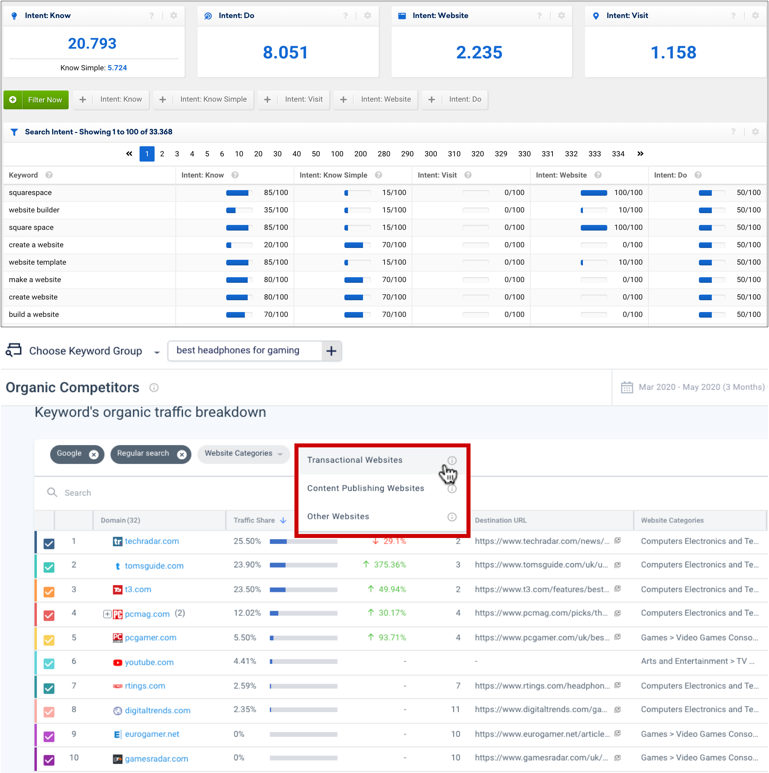 Most of the times I assess a site with rankings drops after a Google Core Update I find that (among other things) it had issues when fulfilling the previously ranked queries intent due to the context: it was ranking for whether broader queries with too granular content, or with content with a different nature and an organization/structure/layout that doesn’t provide the best answer and comprehensive experience to fulfill the search need.
Most of the times I assess a site with rankings drops after a Google Core Update I find that (among other things) it had issues when fulfilling the previously ranked queries intent due to the context: it was ranking for whether broader queries with too granular content, or with content with a different nature and an organization/structure/layout that doesn’t provide the best answer and comprehensive experience to fulfill the search need.
To avoid losing rankings due to “content quality” issues or rank for queries while not fulfilling the user intent with poorer conversions as a result, it’s then fundamental to, on one hand identify the intent of the queries, analyze the “anatomy” of the SERP and which are the characteristics of the already well ranked pages, to better detect the queries to target.
On the other, do it so with those actually relevant queries with the content type, format and structure/organization offering comprehensive and expert validated information that will better fulfill the user intent through the search journey vs. your competitors, allowing you to achieve your services/products goals in a way that establishes your expertise and trustworthiness in the subject matter with your audience.
What will you achieve with it?
- Understand how your audience search through the customer journey and the different type of information they look for to fulfill their needs, and which are those terms that you actually want to target based on your goals
- Identify the characteristics of best ranked content and search features for your targeted queries, to help you develop content that can provide a better, more comprehensive experience
- Better develop, structure, organize and format your content to fulfill the user search needs and intent
- Establish your Web content/offering expertise and trustworthiness to fulfill the audience needs
Key questions to ask:
- What questions my audience ask when going through their search journey?
- Are these questions satisfied directly in the SERP?
- Which are the queries that I should prioritize to target based on my business goals?
- What are the content characteristics, type, format to develop and where it should be integrated to better fulfill the user intent, leverage search features and provide a better experience than those already ranking in top positions?
- Is your content giving the most up to date, comprehensive, expert validated information to your audience through the best presentation? Doest it help to establish your brand credibility and expertise?
- If you’re indexing content that is not delivering value, hurting your site quality perception and not targeting a relevant search demand to make it worthy to optimize, how you effectively prune it?
How to make it happen:
- Search Intent and SEO. A practical guide by Gianluca Fiorelli
- Search Intent: A Smart Marketer’s Battle Guide by Brendan Hufford
- How To Do Keyword Research in 2020 by Nick Eubanks
- The Importance of Topic Clusters Maret Reutelingsperger
- Optimizing Content in Category Pages while Keeping its Commercial Nature
- What is E‑A-T? Why It’s Important for SEO by Joshua Hardwick
- Google’s E-A-T / Content Quality Questions [Google Sheet]
- How to Improve Your Website’s E-A-T by Lily Ray
- How to Prune your Website Content in an SEO Process
3. Expanding your Presence and Visibility Share leveraging Google’s Search Features and Discover
Why is this so important in 2021?
Most of search results for competitive queries that matter will likely be featuring a search feature, including information to better fulfill users search intent: Using RankRanger SERP Insights we can see that 9.97 of mobile search results in the US include a featured snippet, 23.3% show a FAQ or How-To, 12% a video carrousel, 25.38% rich cards.
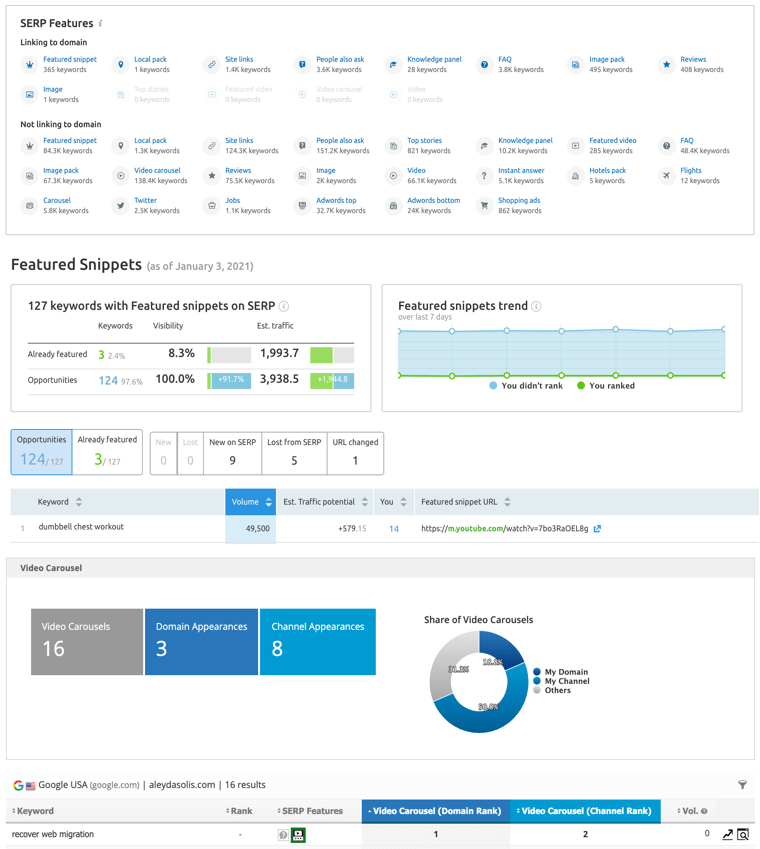 Beyond an additional visibility share, search results CTR curve is also impacted by these as can be seen in Advanced Web Ranking CTR Study.
Beyond an additional visibility share, search results CTR curve is also impacted by these as can be seen in Advanced Web Ranking CTR Study.
Search features will be triggered through Structured Data (FAQs, How-To’s, Ratings/Reviews, etc.), your content structure (featured snippets), content format (video or image carrousel, Web stories, etc.) or a combination (top stories, popular products, etc.), so is critical to take into consideration when identifying queries to target and mapping with existing content to optimize or new content to create.
It’s also noteworthy that besides expanding your SERPs visibility and CTR through some of these additional content types, such as videos, products feeds or Web stories, they will also allow you to better leverage the visibility and traffic of additional platforms, eg: YouTube (videos), Discover (Web Stories), Shopping Tab (Products).
This is something important to do not only for your non-branded queries, but also for your branded ones to maximize your presence (establishing your authority further through search results) by optimizing Your Brand SERP.
What will you achieve with it?
- Improved SERPs visibility and CTR through the relevant search features for your targeted queries
- Expanded reach through additional platforms depending on the content formats
- Better inform Google about the content meaning via structured data
Key questions to ask:
- What search features are included in mobile and desktop search results for my targeted queries?
- Which are relevant for my content to leverage taking into consideration my goals and are feasible to optimize or develop complying with technical and editorial guidelines?
- Which of these efforts will allow me to expand my content reach outside of Google’s SERPs?
How to make it happen:
- Rich results:
- Featured snippets:
- Knowledge panel:
- Surfaces Across Google:
- Web Stories
- Google Discover:
- Video:
4. Growing and Leveraging Your Brand Authority
Why is this so important in 2021?
Because building and leveraging your brand is likely the best way to build and scale your link popularity while following Google’s guidelines, and if you want to rank for anything competitive nowadays: you’ll need links. Of course, building links is not the reason, but a by-product of building a brand -generating awareness of your business-, which will bring many other benefits beyond SEO, that will ultimately allow you to be better recognized by your audience facilitating not only search, but also direct traffic and conversions.
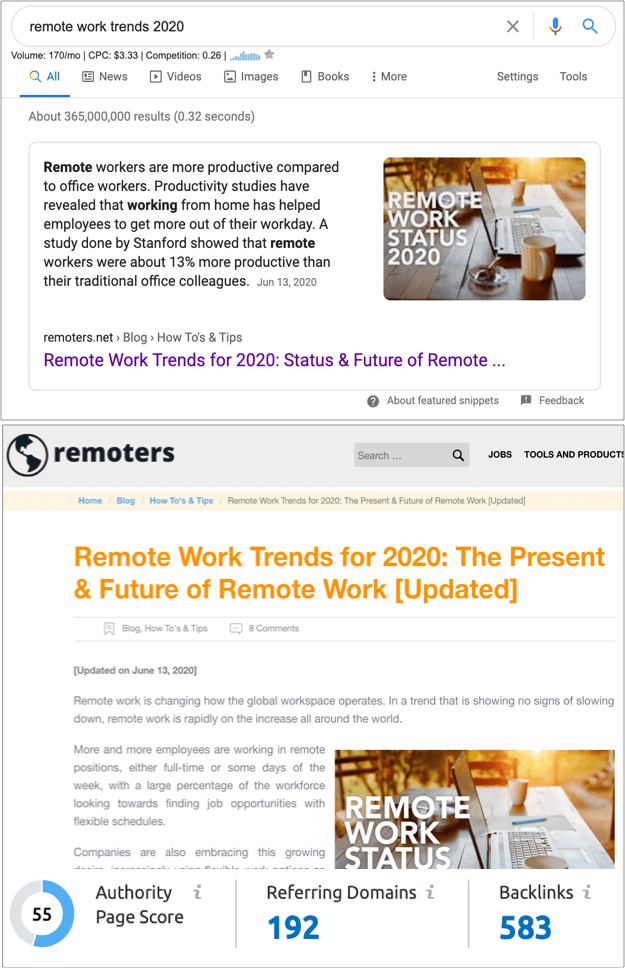 This is why there’s a digital PR overlay in SEO and more specifically, link building campaigns: online PR campaigns promote and communicate what the company is doing to establish its brand awareness and authority, from useful guides, handy tools, industry studies and reports, new features releases, etc. that will end up being shared, published and endorsed, attracting links, mentions, traffic and ultimately, sales.
This is why there’s a digital PR overlay in SEO and more specifically, link building campaigns: online PR campaigns promote and communicate what the company is doing to establish its brand awareness and authority, from useful guides, handy tools, industry studies and reports, new features releases, etc. that will end up being shared, published and endorsed, attracting links, mentions, traffic and ultimately, sales.
This has a “flywheel” effect as brand building compounds: after a few successful campaigns, your brand name will be out there and recognized to be the best at what you do, you’ll be asked to for interviews, online events, webinars, testimonials, etc. that will mention and link you as an trustworthy authority to follow and buy from.
For excellent examples, take a look at Rise at Sevens BEST digital PR campaigns of 2020 and Neomam’s Looking Back On 2020: 25 Campaigns We Produced and Promoted During a Global Pandemic.
What will you achieve with it?
- The link popularity and a share of the authority you need to rank for competitive queries
- Branded searches to maximize your visibility and own much more easily
- Direct traffic and conversions
Key questions to ask:
- What’s your Unique Selling Proposition?
- How do you want to be known as a brand?
- What does your audience like to share and link to? Where do they do it? Who do they follow and read?
- What assets/resources you already have or can build that can connect with your audience preferences?
- How, where and with whom should you promote your assets/resources to be covered?
How to make it happen:
- Link Building & Outreach in an SEO Process: Common Mistakes & Tips for Success [Crawling Monday’s with Gisele Navarro and Carrie Rose]
- The State of Link Building Report 2020 by Aira
- Don’t Be a Link Builder: 7 Deadly Link Building Sins Y’all Are Committing by Bibi Raven
- How to Find Sites That Will Want to Link to Your Content by Gisele Navarro
- The link building book by Paddy Moogan
- Everything Google’s John Mueller said about links in 2020 by Carrie Rose
To Stop:
1. Giving a bad user Web experience
Why is this so important in 2021?
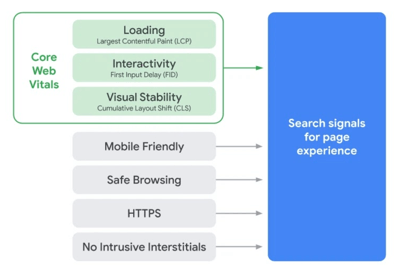 You want your users to trust you and facilitate their journey (and conversions) on your site when they land on it, whatever the device and connection speed.
You want your users to trust you and facilitate their journey (and conversions) on your site when they land on it, whatever the device and connection speed.
Additionally, page experience is becoming a ranking factor in May and Google is fully switching to a Mobile “only” index in March 2021.
Although in the past Google already took into consideration individual signals connected to a good user experience as speed, mobile friendliness, HTTPS and lack of intrusive interstitials, these are going to be combined with Core Web Vitals — that measures loading performance (LCP), interactivity (FID), and visual stability (CLS) — as a new “page experience” signal that will roll out in May 2021.
Despite this, in the 2020 SEO Chapter of the Web Almanac analyzing 7.5M sites from the HTTP Archive, it was found that only 33.13% of websites scored Good Core Web Vitals for desktop while only 19.96% of their mobile counterparts passed the Core Web Vitals assessment. Now it’s then the time to ensure your Web experience is the best, from speed, mobile friendliness, security to lack of intrusivity.
What will you achieve with it?
- A fast, secure, non-intrusive, mobile friendly Website that provides the best user experience that delights your users, establish trust and facilitates their conversion.
- Avoid losing rankings due to a bad page experience signal.
Key questions to ask:
- Is my Website mobile friendly?
- Is my Website secure, completely running in HTTPS without issues?
- Does my Website show intrusive interstitials/pop-ups?
- Is my Website fast with a LCP lower than 2.5 seconds and a FID lower than 100 ms?
- Is my Website visually stable with a CLS of less than 0.1.?
How to make it happen:
- Understanding page experience in Google Search results by Google
- Web Vitals in Web.dev
- Competitive Speed & Core Web Vitals analysis with Free Tools [Twitter Thread]
- Free Page Experience Tools (Core Web Vitals, HTTPs Usage, Safe Browsing, No Intrusive Interstitials)
- The Ultimate Guide to Page Experience by Onely
- 7 Tips to Improve Your Core Web Vitals Scores & Page Experience Signals by Rachel Costello
- Business Success with Core Web Vitals by Izzi Smith
2. Generating unnecessary technical barriers for your content to be indexed and ranked
Why is this so important in 2021?
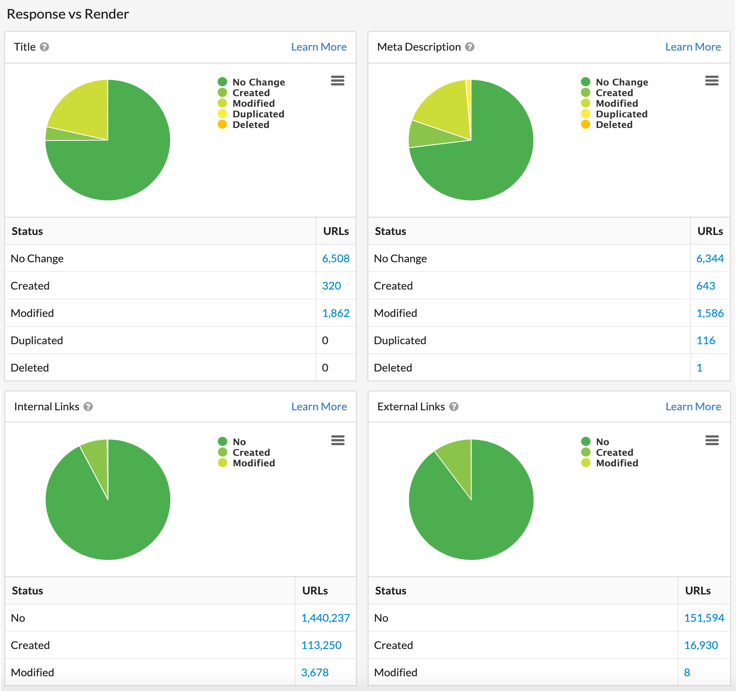 The popularization of JavaScript Frameworks to build more dynamic Web platforms, and the “over” reliance on JS to not only provide features that could otherwise be implemented via simple HTML and CSS (that is sometimes not even fully used by every page), but also to use client side rendering to feature core Web content and navigation, has added additional “barriers” to search crawlers -besides the already existing crawlability and indexability ones related to canonicalization, internal linking, etc.- to effectively access fully to Websites content to index and rank.
The popularization of JavaScript Frameworks to build more dynamic Web platforms, and the “over” reliance on JS to not only provide features that could otherwise be implemented via simple HTML and CSS (that is sometimes not even fully used by every page), but also to use client side rendering to feature core Web content and navigation, has added additional “barriers” to search crawlers -besides the already existing crawlability and indexability ones related to canonicalization, internal linking, etc.- to effectively access fully to Websites content to index and rank.
Although is true that both Google and Bing have evolved to run JavaScript by crawling with an evergreen version of Chromium and adopting Microsoft Edge, Websites -especially big ones- will tend to face issues due to the higher number of pages, resources, rendering cost and available crawl budget, which for Google is determined by crawl capacity limit and crawl demand.
In the 2020 SEO Chapter of the Web Almanac analyzing 7.5M sites from the HTTP Archive, disparities were found across rendered and non-rendered HTML. For example, the median mobile page displays 11.5% more words when rendered than its raw HTML, indicating a reliance on client-side JavaScript to show content.
Bartosz Góralewicz has shared in the past indexing analyses including the “Rendering SEO manifesto“, showing how “on average, 10-15% of your pages are not indexed by Google. Moreover, if your content relies on JavaScript the risk goes up: 40% of an average website’s JavaScript-powered content is not indexed.”
On the other hand, Google is fully switching to a Mobile “only” index in March 2021, nonetheless even if the switch started already a few years back and they have been sharing the relevant mobile first guidelines, non-trivial disparities are still found across mobile and desktop pages, like the one between mobile and desktop links, illustrated in the 62 links on mobile versus the 68 links on desktop for the median web page, based on the 2020 SEO Chapter of the Web Almanac insights.
It’s then fundamental when doing technical SEO audits to assess the content and navigation/links elements relying on JavaScript as well as content accessibility to mobile vs. desktop search crawlers, besides the “usual” crawlability and indexability analysis making sure that the different levels and areas of the site meant to be indexed and ranked are easy to be found and link popularity is passed based on their importance.
This is thankfully facilitated with JS and mobile support (and comparison features) of SEO crawlers as well as reports on Google Search Console (Crawl Stats report, Index Coverage, URL Inspection Tool) and the new Bing Webmaster Tools.
What will you achieve with it?
- Make sure that your meaningful, meant to be indexed and ranked content is effectively accessed and rendered by search crawlers
- Your content is both correctly accessible to mobile and desktop crawlers
- Avoid wasting your crawl budget by crawling and indexing content that is not meant to be ranked
Key questions to ask:
- Are you relying on client side rendering to render meaningful content, SEO related configuration or links?
- Are all the necessary resources to render your site content accessible to search bots?
- Is your content accessible in a similar way to mobile crawlers as well as to desktop ones?
- Are the meaningful, meant to be ranked pages of your sites effectively linked internally and indexed?
- Are you wasting your crawl budget on not meant to be indexed nor ranked pages?
How to make it happen:
- Controlling Crawling and Indexing: the Ultimate Guide by ContentKing
- Large site owner’s guide to managing your crawl budget by Google
- Understand the JavaScript SEO basics by Google
- The Ultimate Guide to JavaScript SEO by Onely
- JavaScript SEO Resources by Sitebulb
- Mobile-first indexing best practices by Google
- A Guide to Mobile First SEO
- SEO For Marketplaces: Overcoming Technical Challenges
- When Your Inventory Changes: SEO Tips For Changing Product Pages
- SEO-Friendly Pagination: A Complete Best Practices Guide by Jes Scholz
3. SEO Implementation Blockers and Horror Stories with a Healthy SEO Framework and Agile Process leveraging automation
Why is this so important in 2021?
There’s a lack of resources availability, flexibility and consistency in the support of SEO implementation that ends up causing the failure of SEO processes. We need then to establish in a system that minimizes these issues by following a framework and an agile approach that minimize and identify & tackle issues quickly.
On one hand, technical and content resources availability and flexibility issues are consistently mentioned as the top reasons of why SEO processes fail, followed by lack of completion of SEO implementations and understanding/education by the involved project team.
We spend non-trivial time developing use cases, forecasting results, aligning and prioritizing our efforts along the development and product roadmaps as well as marketing and content calendars, and many times we see these efforts truncated due to delays and reliance on third party teams.
It’s then important to have an agile mindset in our SEO project management approach for continuous, small and quick releases, quickly identifying blockers and adapting to changes, leveraging available solutions to automate when viable to see results faster and earn the needed support to fully implement recommendations. In the last few years SEOs like Hamlet Batista have been showing how to leverage Python to do things like Generating FAQs with the relevant Schema, Producing Quality Titles & Meta Descriptions Automatically, or Automated Intent Classification to start “self-serving” and minimize the reliance on other teams across many use cases.
We then also have Agile/Edge SEO tools like RankSense (from Hamlet Batista) or Sloth (from SALT Agency / Dan Taylor) that offer something similar at a different level: leveraging Cloudflare workers to avoid Web development bottlenecks to implement from meta tags, redirects, pre-render JS, hreflang and more, to be able to show results fast and gain further “and proper” development support to implement these and much more with far less restrictions.
On the other, we also face never ending, preventable mistakes through the SEO implementation process, also known as #SEOHorrorStories, that seem to happen all the time, causing issues and delays in scenarios that could be avoidable with an effective communication, coordination as well as mix of manual and automated validation system in place across the different types of SEO activities, from technical configurations changes, to content updates or rankings/traffic shifts.
This is why an SEO Framework is necessary to tackle education, validation and monitoring activities through the SEO process, to align understanding and efforts through the different teams involved in the SEO process, while leveraging automation when viable to avoid development bottlenecks and relying only on “manual” validations that are prone to errors, using already existing SEO alerts solutions such as Little Warden or ContentKing.
Here’s an example of a “Healthy SEO Framework” and the different areas covered:
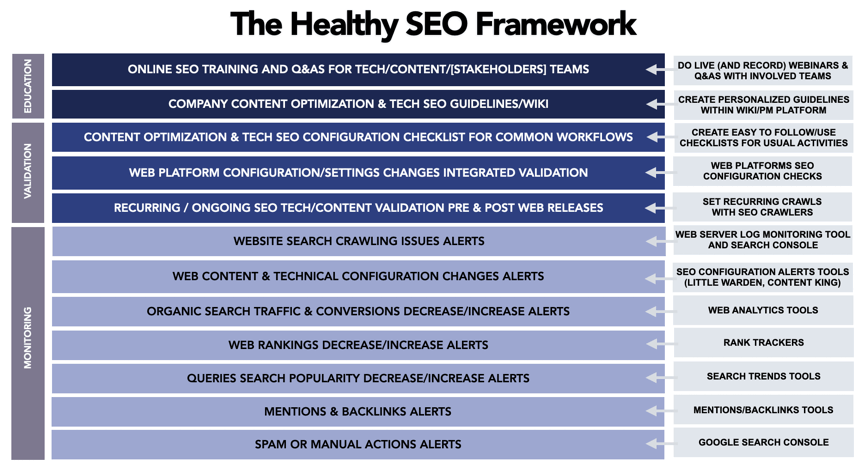
What will you achieve with it?
- Be proactive to avoid and identify fast SEO mistakes and #SEOHorrorStories that will negatively impact your SEO results
- Identify and react to SEO implementations issues/blockers fast to avoid delays
- Prove the worth of SEO fast to gain further support avoiding/minimizing resources bottlenecks
- A better aligned, cost-effective and supported SEO process across the different areas involved
Key questions to ask:
- Do you have the required technical and content resources and support to see the expected results on time? If you don’t, what other implementation channels you have access to make your goals happen in another way?
- What do you need to gain the required support to implement the different alternatives of SEO implementations?
- How can you prevent the most common SEO mistakes/issues to happen again?
How to make it happen:
- The Worst Technical SEO Nightmares and How to Avoid Them
- Edge SEO: Implementing Technical SEO Changes via CDN – How does it work and when to use it. [With Hamlet Batista and Dan Taylor]
- Power up your marketing workflows with Python and JavaScript by Hamlet Batista
- SEO Automation in 2021 by Andrea Volpini
- Agency Automator’s Videos How-To’s
- Python for SEO: Complete Guide (in 5 Chapters) by Jean-Christophe Chouinard
- 7 Example Projects to Get Started With Python for SEO by Ruth Everett
Let’s win SEO in 2021
Now more than ever, SEO is not a one-trick pony, and needs to align efforts and support from the different involved areas (technical, content, promotion) in a cohesive way to be competitive.
It should be also driven by strategical business goals to achieve feasible, tangible and meaningful results, taking into consideration the current challenges as well as leveraging new features and opportunities within search.
The ultimate goal is to become the most comprehensive and authoritative answer that provides the best experience and fulfill your relevant audience search needs, independently of the location, device, connection or format.
Want to see more about doing SEO in 2021? Check out:
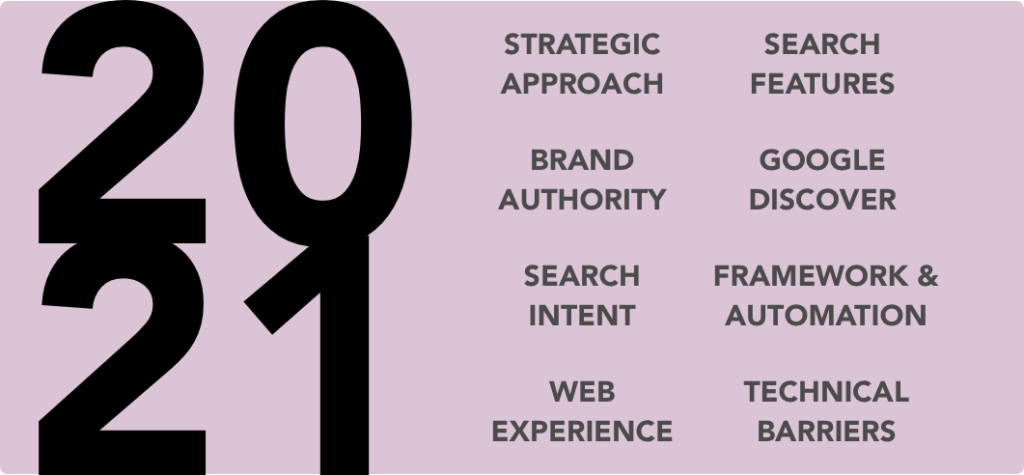
1 Comentario
This article is like an seo gold mine! So much amazing info and all the links are perfect for expanding on the material. Thanks for the effort you put into this!